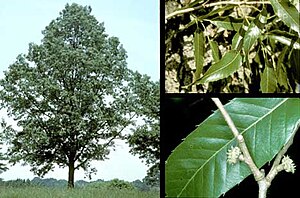Japanese chestnut oak
| Japanese chestnut oak | ||||||||||||
|---|---|---|---|---|---|---|---|---|---|---|---|---|

Japanese chestnut oak ( Quercus acutissima ) |
||||||||||||
| Systematics | ||||||||||||
|
||||||||||||
| Scientific name | ||||||||||||
| Quercus acutissima | ||||||||||||
| Carruth. |
The Japanese chestnut oak ( Quercus acutissima ), also called sawn oak or silkworm oak , is a deciduous tree from the oak genus .
description
The Japanese chestnut oak is a deciduous tree up to 30 m high . Young twigs are 1.5 to 2 mm thick and have yellowish-gray tomentose hairs. Older branches become bald, turn yellowish-gray and form lenticels , which are yellowish-brown in color.
The leaves are on 1 to 3, rarely up to 5 cm long, initially felty, later becoming bald petioles. The leaf blade is narrowly elliptical-lanceolate, 8 to 19 cm long and 2 to 6 cm wide. Both sides of the leaf are colored the same, initially tomentose, later completely balding or only tomentose on the veins of the underside of the leaf. The leaf base is rounded or broadly wedge-shaped; the leaf margin is serrated spiky; the tip long pointed. On each side of the median vein there are 13 to 18 tributary veins that terminate at the teeth of the edge. The tertiary veins emanating from the secondary veins are slender but clearly visible on the underside of the leaf and more or less parallel.
The acorns arise on the branches of the previous year, stand individually or in pairs. Flowering begins in March to April, the fruit is ripe in September to October of the following year. The fruit cup is cup-shaped to disc-shaped and - including the bracts - has a diameter of 1.9 to 4.2 cm. The bracts are awl-shaped to tongue-shaped, about 1.5 cm long, bent back and greyish. The nut is up to a quarter of the fruit cup enclosed in half, it is ovoid to ellipsoidal, 1.5 to 2 × 1.7 mm in size to 2.2, two colors from orange to the base with a sliding color transition to green-brown at the top. The tip of the fruit is depressed, the stigma has a diameter of 1 cm and is raised. The stylopodium has a diameter of about 4 mm and is silky, slightly grayish-brown in color. The fruits are very bitter and are mostly eaten by birds.
The number of chromosomes is 2n = 24.
distribution
The home of the Japanese chestnut oak is in Korea , Japan , China and the Himalayas . In eastern North America it is cultivated very often (mostly to provide wild animals with acorns as food) and is partly naturalized there; in Central Europe, on the other hand, this species is rarely seen in large gardens and collections.
Systematics
The first description by the English botanist William Carruthers was published in 1862; the introduction of the species to Great Britain is dated the same year .
Individual evidence
- ↑ Huang Chengjiu, Zhang Yongtian and Bruce Bartholomew: Fagaceae. In: Flora of China , Volume 4, 1999. Pages 314-400.
- ↑ Quercus acutissima at Tropicos.org. In: IPCN Chromosome Reports . Missouri Botanical Garden, St. Louis
- ↑ See web link GRIN.
- ↑ See for example literature Whittemore.
- ↑ See for example literature Mitchell.
- ↑ J. Proc. Linn. Soc., Bot. 6:33. 1862. See web link GRIN.
- ↑ See literature Mitchell.
literature
- Alan Mitchell, translated and edited by Gerd Krüssmann: The forest and park trees of Europe: An identification book for dendrologists and nature lovers . Paul Parey, Hamburg and Berlin 1975, ISBN 3-490-05918-2 .
- Alan T. Whittemore: Sawtooth Oak (Quercus Acutissima, Fagaceae) in North America . In: Sida, Contributions to Botany . tape 21 , 2004, p. 447-454 ( abstract at USDA ).
Web links
- Entry in GRIN Taxonomy for Plants (English)
- Entry as an invasive plant in North America at invasive.org (English)
- Entry at VirginiaTech with distribution maps in North America (English)
- Datasheet at NC State University (English)
- Sheet at the University of Florida (English)
- Data sheet at hort.uconn.edu (English)